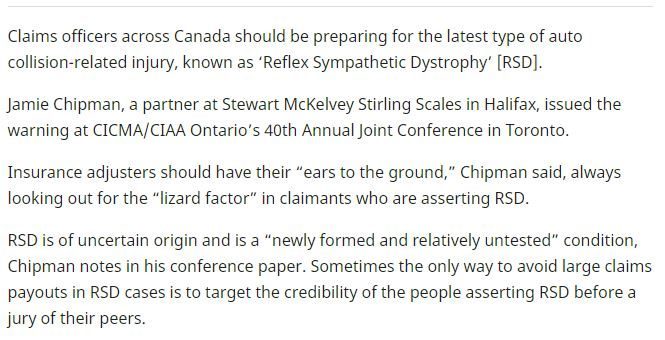When I started searching online for information on CRPS/RSD in May, I started with medical journals and other reputable sources. Which is how I found out why this disease has 2 different names. The name Reflex Sympathetic Dystrophy was replaced by Complex Regional Pain Syndrome:
at a consensus workshop in Orlando, Florida, in 1994, with the new name and diagnostic criteria codified by the International Association for the Study of Pain (IASP) task force on taxonomy”.(1)
Every now and then I’d Google-search a specific term or expression, to find more information about this disease. Which is how I ended up reading this particular ‘news’ item about itD in Canadian Underwriter, an insurance industry publication; I’d been trying to find the CRPS incidence rates in Canada.
And I was horrified at what I read. I’ve included an excerpt below, with emphasis added. But first, pretend for a few moments that you or loved one has CRPS, and then imagine how they’d feel reading this ‘news’ item. My neuro-anaesthesiologist (two words that I’d never have imagined would apply to me!) once described CRPS to me as:
a truly nasty invisible and rare neuroinflammatory disease that causes excruciating pain and can also lead to joint damage as well as localized vascular issues”.
The pain of CRPS is severe neuropathic pain, the same type of pain that terminal cancer patients experience. But it’s chronic; all the time. And it’s often permanent. Sometimes it’s so bad that the affected arm or leg is… amputated. So it’s obviously not something to take lightly. So this piece, in an insurance industry magazine, horrified me. And then it made me very angry. Insurance
Claims officers across Canada should be preparing for the latest type of auto collision-related injury, known as ‘Reflex Sympathetic Dystrophy’ [RSD].
Jamie Chipman, a partner at Stewart McKelvey Stirling Scales in Halifax, issued the warning at CICMA/CIAA Ontario’s 40th Annual Joint Conference in Toronto.
Insurance adjusters should have their “ears to the ground,” Chipman said, always looking out for the “lizard factor” in claimants who are asserting RSD…
“The nature of the injury must be carefully documented, as well as the circumstances surrounding the original event.
Also, Chipman says, since the credibility of the person suffering the pain is an issue, insurers should find any past employment, medical or even school records that might bear on the origins of the RSD symptoms being claimed.
All efforts should be made to try mitigation arguments”.(2)
What they’re suggesting is that (all?) CPRS patients’ credibility is questionable at best, so an insurance company trying to refuse a claim should try to attack the patient – and their credibility. I have a biomedical ethics (i.e. bioethics) background, and from that perspective this is absolutely horrifying. And very surprising in Canada, where we have provincial public healthcare systems.
I then Google-searched the author, to see whether this could have been an April Fools’ Day prank; it was published on April 1, 2007. But there was nothing on-line to show that this could have been a (bad) joke.
In case you’re curious, these are the 1994 signs & symptoms agreed on by the 1994 IASP task force – a group of physicians who’ve specialized in pain conditions – for CRPS:
Continuing pain, which is disproportionate to any inciting event, as well as evidence of (1):
- Hyperalgesia (to pinprick)
- Allodynia (to light touch and/or temperature sensation and/or deep somatic pressure and/or joint movement)
- Temperature asymmetry (>1°C)
- Skin color changes and/or asymmetry
- Edema, disproportionate to any existing injury or condition
- Sweating changes and/or sweating asymmetry
- Decreased range of motion and/or motor dysfunction (weakness, tremor, dystonia)
- Trophic changes (hair, nail, skin)”(1)

References:
(1) Harden RN, Bruehl S, Stanton-Hicks M, Wilson PR. Proposed New Diagnostic Criteria for Complex Regional Pain Syndrome. Pain Medicine, Vol 8 (4), 326-331. 1 May 2007 (Published: 12 Feb 2007). Web: https://doi.org/10.1111/j.1526-4637.2006.00169.x
(2) Gambrell, David. The Mysterious Case of RSD. Canadian Underwriter. 01 Apr 2007. Web:
